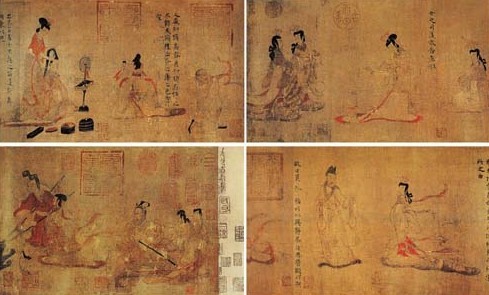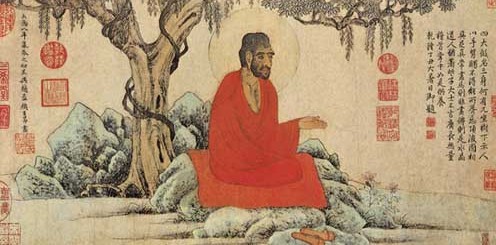| Home > China Feature |
The Origin of Buddha Paintings
Buddha paintings can be traced back to the Sakyamuni age between the 6th to 5th centuries B.C. According to the record, after Sakyamuni became the Buddha, a rich businessman was converted. To invite the Buddha to spend the rain retreat of the monsoon period, he bought a garden in Sravasti, in which he built a bedroom, a storage room, a warehouse, a living room, a bathroom, and a pool – almost everything but paintings. Hence he began to paint Buddha paintings in it, which was the earliest start of Buddha paintings.
Early Buddhism held that the image of Sakyamuni was indescribable, and any artistic method could not present his specific image. Therefore, for over 200 years until the age of Ashoka the Great (273 B.C. – 232 B.C.), Sakyamuni could not be found in Buddha paintings of India. Symbolic methods were used in paintings and basso-relievo to display the pre-life and present life of Sakyamuni. For instance, a footprint means the Buddha had arrived, and dharma-cakra, throne, or banyan was used at the place where Sakyamuni spoke Dharma. Until the second century at the Age of Gandhara, the image of Sakyamuni began to emerge in the paintings.
In China, the earliest record on Buddha paintings was in the reign of Emperor Ming of the Eastern Han Dynasty, and they started to prosper in the Wei, Jin, and Southern and Northern Dynasties. The representative artists included Dai Kui, Gu Kaizhi, Cao Zhongda, and Zhang Sengyao. The Fifth Buddha (Wu Shi Fo), the representative work of Dai Kui in the Eastern Jin Dynasty, the Painting of Vimalakirti by Gu Kaizhi of the Eastern Jin Dynasty, and the jade Buddha sent from the Lion Kingdom (Sri Lanka) were reputed as “Three Wonders” at that time.

the Painting of Vimalakirti by Gu Kaizhi
In the Tang Dynasty, the early- and mid-Tang painting style represented by Wu Daozi and Zhou Fang was highly praised in history for creating the temple mural with dynamic effect like “wind blowing on the whole wall.”
Wu Daozi was a master of Buddha paintings, murals in particular. He created some 300 murals in Chang’an and Luoyang. When painting murals, he often finished at one stroke, and was crowned “Painting Sage” by later generations. His representative Buddha painting was Hell Conversion (Diyu Bianxiang). The Painting of Six Aryas (liu zunzhe xiang) by Lu Lengjia, a disciple of Wu Daozi, is also one of the masterpieces of extant Buddha paintings.

Indian Monk in Red by Zhao Mengfu
Zhou Fang had profound artistic achievements and consummate painting skills. He was known for his court lady paintings as well as Buddha paintings. In regards to the latter, Zhou Fang gradually formed his own artistic style – water-moon (shuiyue) style, which was displayed in his painting of Boddhisattva. It was known for soft brushwork and dignified image, thus dubbed Water-moon Boddhisattva by the later generations.
Well-known Buddha paintings include Indian Monk in Red and Painting of Amitayus Buddha by Yuan Dynasty (1271 – 1368) painter Zhao Mengfu, and Ding Yunpeng’s Painting of Arhats, Painting of Sakyamuni Meeting, Painting of the Origin of Dharmadhatu, etc.
Art
 more
moreChina Beijing International Diet ...
Recently, The hit CCTV documentary, A Bite of China, shown at 10:40 ...

Exhibition of Ancient Chinese Jad...
At least 8,000 years ago, Chinese ancestors discovered a beautiful...

Longmen Grottoes
The Longmen Grottoes, located near Luoyang, Henan Province, are a tr...

Custom
 more
moreWeb Dictionary
Martial Arts
Tai Chi Master Class Held in Moscow
MOSCOW, June 15, 2016 (Xinhua) -- Students learn from Shaolin ...
Celebriting 70 years' efforts in restoring Mogao...
Work is being carried out at the restoration site of cave No 98 a...
Hong Kong Children's Symphony performs in Seattle
Under the theme of Tribute to the Golden Age, a concert featuring a ...





 print
print  email
email  Favorite
Favorite  Transtlate
Transtlate 








